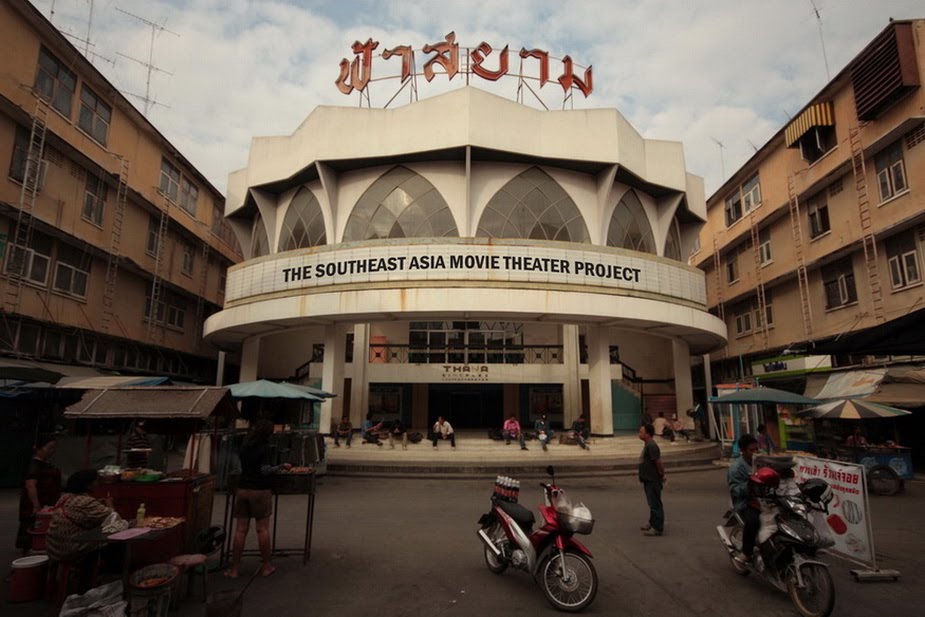"Fifteen theaters were built throughout Thailand in this exact same style," he said, pointing in the direction of the abandoned behemoth at the far end of the field. Juxtaposed against the surrounding structures - dingy, mostly one-story shop houses - the citrus-hued theater glowed like the final minutes of a tropical sunset.
He continued:
"The architect started with one theater. That one was a success, so he got more commissions, reusing the original blueprints again and again for a total of fifteen times. But the only other one I know of for sure is in Ubon. Or maybe it's Yasothon. I can't seem to recall."
Mr. Samaan, former manager of the
Khampaeng Saen Rama and current neighbor to it, cycled through a list of facts and figures about his former place of employment. In the 80's and 90's he rented it from its owner, overseeing the day to day operations from the procurement of movies, to promotion and exhibition. Being the only venue in town since the rival
Trisuk Theater went out of business, Mr. Samaan had under his supervision the lone ticket to another world - a fact he was eminently aware of.
A blast of color, the Khampaeng Saen Rama
Being the second theater to be commissioned in the town of Khampaeng Saen, the Khampaeng Saen Rama was the more luxurious of the two. This dichotomy of comfort had an almost immediate effect upon the older Trisuk Theater, tucked away in the town's central market.
When the Khampaeng Saen Rama opened in 1982, it is likely that the town's movie-going market become over-saturated, leading to a decline in ticket sales at the older Trisuk Theater, which closed down soon thereafter.
The difference in location also played a critical role in the Khampaeng Saen Rama's survival over the Trisuk. In the early 1980's, Thailand's industrial boom was just beginning to take off. The wealth created by the boom led to a further proliferation of private cars into the country - especially in the central provinces where most of the industry was situated. New car owners, pining to show off their hot new wheels with a trip to the movies, would have found parking difficult in the close quarters of the central market, where the Trisuk Theater stood. The Khampaeng Saen Rama, on the other had, was built just on the outskirts of town, along the highway leading towards the provincial capital and beyond. Parking was abundant in the surrounding fields, thus making a trip to the pictures less of a hassle.
Dwarfing surrounding structures, the Khampaeng Saen Rama.
Concession stand beneath the theater, stairs leading to the lobby.
Ribbon windows allow natural light to flood the lobby, while aiding the vines in their quest to colonize.
Left over lobby cards for the 1998 Wong Jing comedy "The Conman," starring Andy Lau.
Ticket window
A mere 25 baht for tickets at the time of the theater's closure in the early 2000's.
Inside the ticket sales room.
Bathroom art: Men's Room
Bathroom art: Women's Room
The equipment room was covered in graffiti, most of which related to movies screened at the theater. One could spend hours reading it all.
Gutted auditorium, once home to 400 seats. A VIP room was located at the rear.
Manager's office with left over Jackie Chan movie poster on door.
Bold signage
Samaan spoke reverently about his old work haunt, recalling capacity crowds for both movies and live concerts alike.
"It was a lively place in its day," he mused. "There were times when the crowd would erupt with excitement or laughter; cheering and jeering for heroes and villains; swaying in their seats, or jumping out of them altogether. Running the place made me feel responsible for all those emotions."
At some point in the late 80's, the
Khampaeng Saen Rama was acquired by the Fred Films circuit, a Bangkok-based second-run theater chain owned by
Mr. Fred Banpreecha. But following a reorganization of the national movie distribution system, whereby the country was divided into exclusive territories between a handful of companies, the notorious Thana Cineplex circuit - subsidiary of
Pranakorn Films - came to control the market in west-central Thailand. Known for the usurious business practice of charging a flat fee for each film instead of the standard revenue split between theater operator and distributor, Thana helped ensure further decline of the
Khampaeng Saen Rama, which was already struggling against a rise of home entertainment consumption.
By the year 1999, the Khampaeng Saen Rama was through, ending a brief but bright run as Khampaeng Saen's cultural heart.
Like many formerly shuttered theaters in small town Thailand, it was given a brief revival in 2001 to screen the royally-backed epic Suriyothai, before once again falling dormant.
As for the remaining 14 theaters throughout Thailand built in the exact same style as the Khampaeng Saen Rama, this is something to be on the look out for. That is, if any still exist.





















































